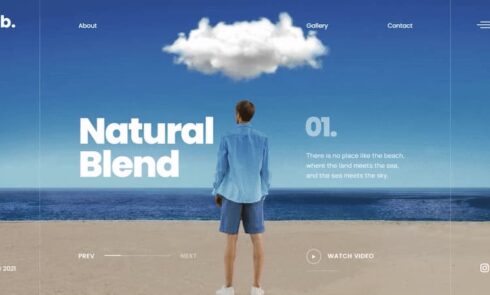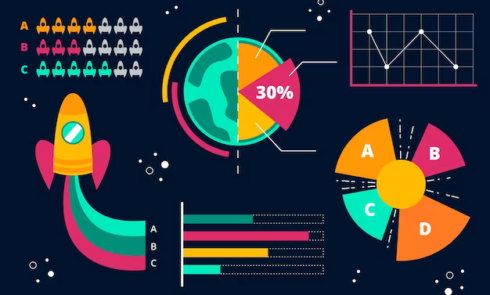When one contemplates captivating websites, text might not immediately spring to mind. However, beyond its fundamental role in design, text possesses remarkable versatility. It can serve as the focal point of a web experience, particularly when animated. Text, in its various forms, holds the power to engage, inform, and guide users through digital landscapes with finesse and creativity.
Incorporating animations and effects into textual elements can transform a static webpage into a dynamic and immersive environment. The seamless integration of text animation not only enhances user experience but also elevates the visual appeal of a website. From subtle fades to elaborate transitions, the possibilities for text animation are endless.
What is the Role of Text Animation in Web Design?
Text animation is not just a decorative element in web design; it’s a multifaceted tool that enhances user experience and communication. Below is a detailed expansion, including a list of its purposes and benefits:
- Establishing Visual Hierarchy: By animating specific text elements, designers can guide users’ eyes to the most important information first, creating a clear path of reading and interaction;
- Directing User Attention: Animation acts as a cue, highlighting changes or important features on a webpage, ensuring users notice and react to them;
- Conveying Information Effectively: Through various animation techniques, complex information can be broken down into simpler, engaging, and easier-to-understand segments;
- Captivating Audiences: Text animation adds a dynamic layer to web content, making the user experience more engaging and less static. It can turn an ordinary visit to a website into a memorable experience;
- Communicating Brand Identity: The style of animation can reflect a brand’s personality—be it professional, playful, innovative, or sophisticated—helping to reinforce brand identity and values;
- Enhancing Overall Narrative: Animation can contribute to storytelling, making the narrative flow more interesting and immersive. It can be used to draw connections between points, emphasize messages, or introduce content in a storytelling format;
- Improving User Engagement: Engaging users with animated text can lead to longer visit times and more interactions with the content, which is beneficial for websites aiming to increase user engagement or conversion rates;
- Facilitating Learning and Retention: Animated text can be particularly effective in educational content, where it can be used to highlight key points, illustrate concepts, and make learning more interactive and enjoyable.
When implemented with care and strategy, text animation serves as a powerful tool in web design, enhancing not just the aesthetics of a website but also its functionality and effectiveness in communication.
Harnessing the Power of Text Animation
Incorporating animations and effects appropriately can enhance user experience and elevate visual appeal. While there are guidelines for text animation usage, creativity often yields the most compelling results. Designers have the freedom to experiment with various animation techniques, from subtle transitions to bold transformations, to create engaging and memorable web experiences.
How to Establish Visual Hierarchy?
Text effects play a crucial role in establishing hierarchy and guiding users through content. Eye-catching effects are typically reserved for headings and key messages, while subtler animations contribute to the overall dynamism of the design. By strategically applying text animation, designers can draw attention to important information, enhance readability, and create a more engaging user experience.
Balancing Creativity and Functionality
While some animations purely serve to dazzle, others contribute to the website’s functionality and narrative. It’s essential to strike a balance to avoid overwhelming the user or detracting from essential information. By carefully considering the purpose and context of each animation, designers can ensure that text effects enhance rather than detract from the overall user experience.
What about Text Animation Techniques?
From parallax scrolling to hover-triggered effects, there is a range of text animation techniques designers employ to engage users. These techniques add depth, movement, and interactivity to web designs, creating immersive and dynamic experiences. By staying abreast of the latest trends and experimenting with new techniques, designers can push the boundaries of text animation and create truly innovative and memorable web experiences.
What about Innovative text animation Examples?
Examining real-world examples illustrates the diverse ways in which text animation can enhance web experiences:
Dynamic Background Text Effects
Change by Design showcases inventive text effects, incorporating animated text as a vibrant background element, creating a visually engaging user experience. By filling the screen with giant text and employing contrasting colors and offset letters, Change by Design creates a sense of dimensionality and energy. As users scroll down, the text colors gently shift, cleverly guiding them through the website and keeping them engaged.
Floating Text Animation
January 3rd’s 2021 recap employs whimsical animations, capturing attention and setting a playful tone for the website. The jumble of letters that move like they’re in water creates a sense of movement and intrigue, drawing users into the content. Combined with quirky colors, huge text, and scroll-triggered effects, the floating text animation adds a layer of visual interest and dynamism to the design.
Scroll-Triggered Text Animation
Mirrows’ NFT website demonstrates the captivating potential of scroll-triggered animations, enticing users to explore further with each scroll. The variety of animations, including text materializing and moving into place, vertical marquees of moving text, and opposing movements, create a hypnotic and engaging user experience. By leveraging scroll-triggered text animation, Mirrows effectively guides users through the website and encourages them to delve deeper into the content.
Text That Joins Together
Pienso’s modern design utilizes smooth text animations to draw users’ attention, particularly with magnetic text effects that enhance readability. The opening screen, where the words of the header come in from different directions as if they’re magnetically attracted to each other, creates a captivating visual effect. This animated effect not only makes the introductory message impossible to ignore but also sets the tone for the rest of the website.
Text Fade-In
UNDOC’s website employs a simple yet effective fade-in animation to convey important information and statistics effectively. Despite addressing serious topics, the fade-in animation adds to the design and amplifies the impact of the content. By seamlessly integrating animation with content, UNDOC creates a visually compelling and informative web experience that resonates with users.
Horizontal Scrolling Text
Waltz Creative utilizes horizontal scrolling text to deliver concise messaging and engage users from the outset, aligning with the agency’s brand identity. The horizontally scrolling hero section, with words like “Rally,” “Revive,” and “Resonate” appearing as users scroll, creates a sense of momentum and dynamism. By effectively communicating the agency’s ethos and services through animation, Waltz Creative captivates users and encourages further exploration.
Sliding Text Animation
Hajk’s sustainable clothing website employs sliding text animations to transition between sections, effectively communicating brand messaging and key information. As users move down the page, text slides horizontally into place, highlighting important points and facts about the organization. By integrating animation with content, Hajk creates a seamless and engaging user experience that reinforces its commitment to sustainability.
Combining Vertical and Horizontal Movement
Bison Studio’s active user experience employs a combination of vertical and horizontal text movement to maintain engagement without overwhelming users. With both horizontal and vertical movement, text animations create a sense of dynamism and fluidity, enhancing the overall user experience. By striking a balance between movement and readability, Bison Studio creates a visually captivating and user-friendly website that keeps users engaged.
Hover-Triggered Text Effects
Smartup Visuals demonstrates how hover-triggered text effects can create a visual hierarchy, guiding users’ attention to essential elements and encouraging interaction. On the opening screen, hovering over specific words italicizes the text, prompting users to linger and explore further. By leveraging hover-triggered effects, Smartup Visuals creates an interactive and engaging user experience that enhances navigation and comprehension.
Scrolling Text Against a Background Image
North Sea’s cinematic web design utilizes scrolling text overlaid on captivating imagery to create a compelling narrative, reminiscent of opening credits in a film. As users scroll down, centered text fades in over shots from the film, creating a sense of anticipation and immersion. By seamlessly integrating video and text animation, North Sea creates an immersive and cinematic web experience that captures the essence of the film and entices users to explore further.
Conclusion
Text animation is a powerful tool that can elevate web design, enhance user experience, and communicate brand identity effectively. By incorporating creative and strategic text animations, designers can captivate audiences, guide users through content, and create memorable and engaging web experiences. As technology continues to evolve, the possibilities for text animation are endless, offering designers new opportunities to innovate and push the boundaries of web design.

